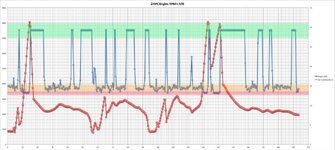mmm-five said:I know I'll get slated for this, but what's the effect on MPG if you add the supercharger - assuming you drive as you do now and only use the extra power 'when needed'?
I'm not asking due to the cost side - although if you're going down from 30mpg to 10mpg it may be an issue - but rather how far can I travel on a tank, as for a daily driver I don't want to have to stop to fill up before I leave, half way, and when I arrive at my destination.
If there is an impact on MPG, then I assume this will increase as you up the power levels.
Personally, I'm aiming for a 25-30% increase as a first step, and then increase it by another 25-30% once I get bored.
I think that's a very legitimate question, especially for you for the mileage that you do.
Fuel consumption is proportionate to the airflow through the engine. Under power, the AFR (Air:Fuel ratio) is around stoichiometric levels (14.7:1) and at WOT, the AFR gets richer (i.e. more fuel used), therefore if the supercharger increases airflow by, say, 50% then you'll use 50% more fuel. Having said that, if you look at the graph below, which I've just produced for you from datalogging my car, you'll see that a fair amount of time, when you're off the throttle, the fuelling is such that the AFR is at 29.2:1 (shaded green section) and it's when you're doing WOT accelerations when the AFR goes below stoichiometric values as shown by the red shaded section.
In the same way that it would be great to have electronically adjustable dampers from the driving seat, it would be great if there was an adjustable geared supercharger which you could simply turn the boost off when travelling on longer journeys from a control module inside the car. You'll have to perfect your eco-mode style of driving on motorways.

